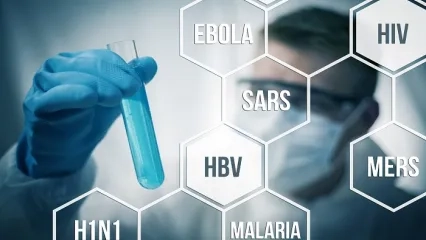Alo Yeditepe
Alo Yeditepe
Symptoms and Treatment of Tick Bites
With the increase in temperatures, there has been an increase in tick cases. Prof. Dr. Meral Sönmezoğlu, an Infectious Diseases and Clinical Microbiology Specialist at Yeditepe University Hospitals, provided important recommendations against ticks that cause life-threatening Crimean-Congo Hemorrhagic Fever (CCHF).
The danger of Crimean-Congo Hemorrhagic Fever (CCHF), one of the viral diseases transmitted to humans by ticks, increases during the summer months. The disease usually starts suddenly with symptoms similar to a common cold. It then progresses with severe bleeding symptoms and can result in loss of life if not treated promptly. Prof. Dr. Meral Sönmezoğlu, an Infectious Diseases and Clinical Microbiology Specialist, emphasized that CCHF has been observed intensively in our country since 2002 and provided the following information that should be known about the disease:
When do the symptoms of the disease start?
The incubation period between the entry of the virus into the body and the onset of symptoms is typically between 2 to 4 days, with a maximum of 9 days. The disease usually starts suddenly with symptoms similar to the common cold. It then progresses with severe bleeding symptoms, and if treatment is not initiated in a timely manner, it can result in a 4-6% fatality rate.
The global situation?
The disease has been sporadically observed in Eastern Mediterranean countries in recent years, but outbreaks have occurred in countries such as Afghanistan, Iran, Iraq, Pakistan, Saudi Arabia, Sudan, and the United Arab Emirates in the past. It continues to be reported in over 30 countries worldwide.
What is the situation in our country?
In our country, the first reported case of Crimean-Congo Hemorrhagic Fever (CCHF) was in 2002 when a patient died from bleeding, and the diagnosis was made from the patient's serum. From that time until 2019, approximately 10,800 cases and 528 deaths were reported, with a case-fatality rate of 4.74%. In 2018, 27 people died, and until May 2019, three people sought medical attention after removing ticks and developing disease symptoms, but unfortunately, they could not be saved. The provinces where CCHF was reported in 2019 were Karabük, Gümüşhane, Samsun, Çorum, Kastamonu, and Sivas. Generally, CCHF is observed between April and October in our country, and in the past two years, it has been most frequently reported in the vicinity of Amasya, Tokat, Çorum, and Sivas. In May and June 2023, three people in Sivas and one person each in Çorum and Amasya lost their lives due to CCHF.
Who are considered at risk for tick bites?
Those considered at risk for the transmission of the disease include individuals living in or visiting endemic areas, farmers, livestock workers, butchers, slaughterhouse workers, veterinarians, healthcare personnel, laboratory workers, and close contacts of patients.
How does Crimean-Congo Hemorrhagic Fever spread?
The main mode of transmission of Crimean-Congo Hemorrhagic Fever is through contact with ticks. In addition to that, it can also be transmitted through direct contact with infected patients (in hospitals or in the community), contact with infected tissues and blood, vertical transmission from mother to baby, and direct contact in laboratory settings.
What are the symptoms of Crimean-Congo Hemorrhagic Fever (CCHF)?
The symptoms of Crimean-Congo Hemorrhagic Fever (CCHF) include sudden onset of fever, chills, headache, muscle aches, fatigue, nausea, vomiting, diarrhea, abdominal pain, and sensitivity to light. After a few days, confusion, restlessness, drowsiness, collapse, lethargy, and pain in the upper right abdomen may occur. Severe cases can involve intense bleeding, coma, shock, multiple organ failure, and can result in death. Recovery usually begins around the 9th or 10th day, with a decrease in fever and cessation of bleeding.
It has been observed that 88% of cases exhibit mild symptoms. It is essential to closely monitor moderate and severe cases in a hospital setting.
How is the correct diagnosis made in case of a tick bite?
The symptoms of the disease are not specific and can be confused with many other illnesses. In the differential diagnosis, brucellosis, typhus, viral hepatitis, malaria, leptospirosis, rickettsiosis, meningococcemia, hematological malignancies, other tick-borne diseases, TTP (thrombotic thrombocytopenic purpura), sepsis, and drug poisoning should be considered. The diagnosis of the disease is primarily based on a history of tick exposure and the presenting symptoms. Blood tests are conducted for confirmation.
How is tick bite treated?
The earlier the treatment is initiated, the lower the rate of mortality. The most important aspects of treatment are fluid and electrolyte monitoring and control of bleeding. If necessary, fresh frozen plasma, platelet apheresis, whole blood, or red blood cell transfusions may be given. Antibiotics do not have an effect on the treatment.
• Stay away from areas with ticks.
• Wear light-colored clothing as ticks are easily visible on them.
• Choose protective clothing such as long socks and long-sleeved shirts.
• Use tick repellent spray before going into open areas.
• If a tick is found, do not touch it with bare hands, squeeze it, or remove it mechanically with tweezers or similar tools.
• If removal is difficult, seek medical attention.
• If fever and fatigue occur after tick exposure, seek medical help without delay.
About
Faculty and Year of Graduation:
Medical Faculty of Ankara University, 1984
”
See Also
- What is Hepatitis B? What are its symptoms? How is it Transmitted?
- What is HMPV Virus? HMPV Symptoms and Ways of Transmission
- Why Is the Flu Lasting Longer This Year?
- What Precautions Should Be Taken Against the Cold Epidemic?
- Don't Be Late Fighting Against Diseases
- Antibiotics Kill Beneficial Bacteria, Not Viruses
- What is Hepatitis? What are the Symptoms and Treatment Methods?
- Summer Infections
- Precautions Must Be Taken Against Loss of Life Due To Infection in Thalassemia
- Information on H1N1 (Swine Flu)
- Summer is Coming... Beware of food poisoning!
- Our Taboos Affect the Increase in the Number of HIV-Positive Cases in Turkey
- Strep A Symptoms and Treatment
- Do Not Put a Cigarette Butt or Pour Olive Oil or Liquid Soap on the Tick
- Reheat the Food You Cooked Only Once!
- HIV Can Be Hidden for 10 Years without Any Symptoms!
- 290 Million People Live Without Knowing They Have Hepatitis
- Things to Consider When Touching Meat at Eid
- What Is Anthrax Disease?
- The Way to Fight AIDS is to Raise Awareness First
- Still Not Too Late For Flu Vaccine
- What is Rhinovirus?
- Fighting with Thalassemia: Meral Yılmaz
- Thalassemia Spreads from the Mediterranean to the Whole of Europe with Migration!
- Early Treatment of Crimean Congo Hemorrhagic Fever is Vital
- Approximately 3 Million Patients Need Blood Transfusions Every Year in Turkey
- When to Get the Flu Vaccine
- Antibiotics Account For 14% of Prescription Costs
- West Nile Virus Replaces Malaria
- It Is Necessary to Try to Be Healthy in order to Be Protected
- A New Flu Outbreak is Expected Every 10 Years
- 63% of Vector-Borne Diseases are Caused by Lyme Disease
- Experts Warn About Flu Risk
- Mosquito Infection Risk
- Why aren’t Antibiotics Working Any More?
- The World Raises an “Alarm” on Antibiotic Resistance!
- What is COVID-19?
- The Mask Requirement was Removed and the Importance of Social Distance Increased!
- How to Prevent COVID-19 in School-Going Children
- WHO (World Health Organization) Warns for Antibiotic Resistance!
- Who Is Threatened by Monkeypox?
- Ways to Prevent Coronavirus
- Swine Flu / H1N1
- Life Returns to Normal with Caution
- What is Monkeypox Virus? What Are the Symptoms of the Monkeypox Virus?
- What is Lyme Disease?
- How to Tell if You Have a Mild Coronavirus?
- Pay Attention to These Rules for COVID-19
- Hand Sanitizer Usage Guide
- The Priority Rule for the Protection from Summer Infections is Hygiene
Alo Yeditepe




